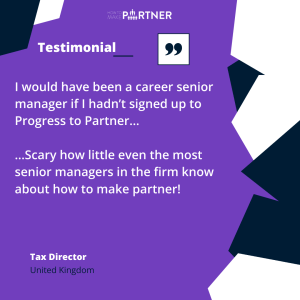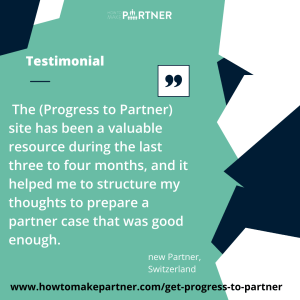Making partner: How long does it take?
When I started in professional services in 2004, making partner by the age of 30 was seen as very, very good going – and only the exceptional people did this. The few partners who did this were always spoken of in hallowed tones, and seen to be the managing partners of the future. Back in 2004, if you hadn’t made partner by the age of 40, you were probably never going to. However, now it is the norm to get made up to partner at around the age of 40. So, what has changed in the last 10 years or so?
The number of partners in a firm is shrinking
Over the last few years the numbers of partners have been shrinking, and will probably carry on this way as the consolidation trend continues across the professional services sector. Therefore, the number of people making partner has shrunk over the last 10 years.
Take a step forward to be in control of your own career progression in your firm. Sign up to my weekly tips here and you’ll find out what you need to be working on in your career development (and how to make the time for your career development) to progress your career in your firm
Why has the number of partners shrunk?
With profit margins reducing over the last 5+ years, partnerships are less willing to reduce the size of the ‘pie’ and therefore are less willing to make up people to the partnership who don’t have a client portfolio. i.e. before you get partner on your business card you need to be a card-carrying rainmaker for the firm. (Not always the case, but you need to have at least demonstrated your potential to win work.)
 Consequently, the time for people to get to partnership has increased over the last 5 years, as new entrants to the partnership need to gain a client portfolio first. From, possibly 10 year to partnership to now more like 15 years. As a consequence, most people are making partnership around the age of 40 now.
Consequently, the time for people to get to partnership has increased over the last 5 years, as new entrants to the partnership need to gain a client portfolio first. From, possibly 10 year to partnership to now more like 15 years. As a consequence, most people are making partnership around the age of 40 now.
Scroll down to read the rest of the article…
Free guides and templates to get you through your firm’s partner track process
An idea of the size of client portfolio you will need to be a partner in a Big 4 firm
What due diligence should I do on my firm before buying in
6 tried and tested tips to ace your Partner Panel Interview
The definitive guide to building a business case for partnership
See whether you are a good fit for partner in your firm
What’s included in the FREE guide:
 1. Extracts from real and successful business cases for partnership
1. Extracts from real and successful business cases for partnership
2. How to structure your business case for maximum impact
3. What questions your business case needs to answer
Click here for more information about the guide
How long for me to make partner?
 Of course, I can’t comment on your own individual circumstances, however, as a rough guide it is worth thinking that it will take 10-15 years, on average to make partner. Therefore, if you enter the profession at 22, then you need to be thinking about making partner at the earliest at 32, and nearer to 37…
Of course, I can’t comment on your own individual circumstances, however, as a rough guide it is worth thinking that it will take 10-15 years, on average to make partner. Therefore, if you enter the profession at 22, then you need to be thinking about making partner at the earliest at 32, and nearer to 37…
Take a step forward to be in control of your own career progression in your firm. Sign up to my weekly tips here and you’ll find out what you need to be working on in your career development (and how to make the time for your career development) to progress your career in your firm
It may be different for senior lateral hires into Big 4 firms
After Arthur Andersen folded and the introduction of Sarbanes Oxley the Big 4 firms all sold off the consulting part of their firm. We’ve now seen the reverse of this decision with the Big 4 firms growing their consultancy arms again, and often making multiple acquisitions of independent practices. As a result, the Big 4 consulting practices are selectively courting senior decision makers from industry into consulting. These people are coming in at Senior Manager or Director level with a view to being rapidly made up to partner if they can prove themselves as work winners.








